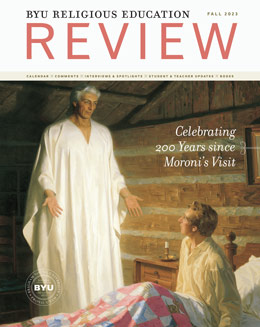Student Symposium and Visualizing Learning Student Art
Adi Marshall
Adi Marshall (adimmarshall@gmail.com) is a student editor at the Religious Studies Center.
I expected my professor to jump straight into the day’s lesson once class started. Instead, he pulled up a flyer for the Student Symposium. I could feel how excited he was about the prospect of students submitting and presenting their papers from their religion courses, and that energy compounded when he announced that there was a second component to the symposium: the Visualizing Learning Student Art Exhibit.
For the first time since the start of both events, the Student Symposium and the Visualizing Learning exhibit were going to be combined as one conference. These events have come a long way since their individual beginnings. For example, the Student Symposium has developed a mentor program, allowing professors to be involved in the publication process with the students. Dr. Mary Jane Woodger, the chair of the symposium, said that she enjoyed participating in the conference because it gives her and other faculty a chance to work one-on-one with students, an opportunity that doesn’t happen as often during an undergraduate degree in religious studies.
Changes have also been implemented in the Visualizing Learning exhibit. The art exhibit has seen an increase in submissions since moving to an online submission form initiated by students rather than faculty recommendations. Dr. Jan Martin, the chair of the exhibit, reported that the total number of entries jumped from eight to fifty-five in 2023. Dr. Martin said it was great to see the art being placed on the same level as the research. She emphasized, “We can’t treat art like it’s less important than academic scholarship, because there is a wide variety of learning styles that students use that are equally effective.”
The goal of both the symposium and the art exhibit is to allow students to showcase that wider variety of learning, and it’s clear that this goal has been achieved. Students have shared how their participation in the events has benefited their academic and spiritual learning. For example, Brock Dowdle presented his paper on scrupulosity, a form of religious OCD, at the Student Symposium. Brock said, “I can do a really intense study of something I was passionate about that was gospel related but not just the scriptures. I used resources that I hadn’t considered previously, like from the RSC website.” Similarly, Marie Heder, one of the finalists in the Visualizing Learning exhibit, shared how her art piece gave her a chance to explore learning in a personalized way. She said, “Everyone has ways that they worship. It’s by divine design that God reaches his children in different ways, and this experience uncovered a window for me to see God in a new way.”
Mentoring has played different roles across these student events. For the symposium, students receive a mentor as part of the presentation and publication process. These mentors provide feedback on the students’ work and give pointers on where to look for more information. When asked about how his mentor changed the way he approached the gospel and his research, Brock shared, “There’s a lot of research and scholarship out there. You can connect all sorts of things to the gospel, even connecting to other religions or religious institutions. There’s truth in different places.”
On the other hand, art is a more personalized form of learning and expression that cannot necessarily be mentored in the same way as a research paper. But there are still ways of mentoring that help the students and their artwork take shape. Marie mentioned how her religion professor was influential in helping her get involved in the exhibit specifically, while her art professor inspired the method that she used for her piece. Marie said, “I love how this made a move toward different ways of learning. The education system has been pretty much the same for a long time, but this felt like a door to something that is so much more beneficial in the education process for an individual. It taught me as an individual rather than as part of a mass.”
This individual mentoring, whether through a project in a religion class, help from a professor, or support from family and friends, is what enables students to branch outside of what they initially thought was possible and gives them the confidence to explore their interests and talents. “Find a subject you enjoy,” Dr. Woodger advises. “Find someone with expertise in that subject, and then let them help you.”
Since initially seeing that flyer in my religion class, it has become increasingly clear how incredible of an opportunity the Student Symposium and the Visualizing Learning Student Art Exhibit can be for everyone involved. Combining the two events has given students and faculty a chance to coordinate in their individual learning and scholarship, and the surrounding community benefits from the students’ presentations at the conference. This last year, the thirty chairs that were set up filled faster than more chairs could be provided. People packed themselves in the available standing room as they came to hear the presentations and view the artwork that the students had prepared. Such a unique opportunity of experiential learning and mentoring truly provides access to a wider variety of learning.
If you are looking to know more about the Student Symposium and Visualizing Learning Student Art Exhibit, contact Beverly Yellowhorse at 801-422-3611 or beverly_yellowhorse@byu.edu. She is a permanent member of the Student Symposium Committee and a vital part of what makes these events run so smoothly. Her support and expertise provide a unique form of mentoring themselves, and Religious Education is indebted to her for her work. You can also find the art presented at the conference on display in the lobby of the Joseph Smith Building until the end of the year.
